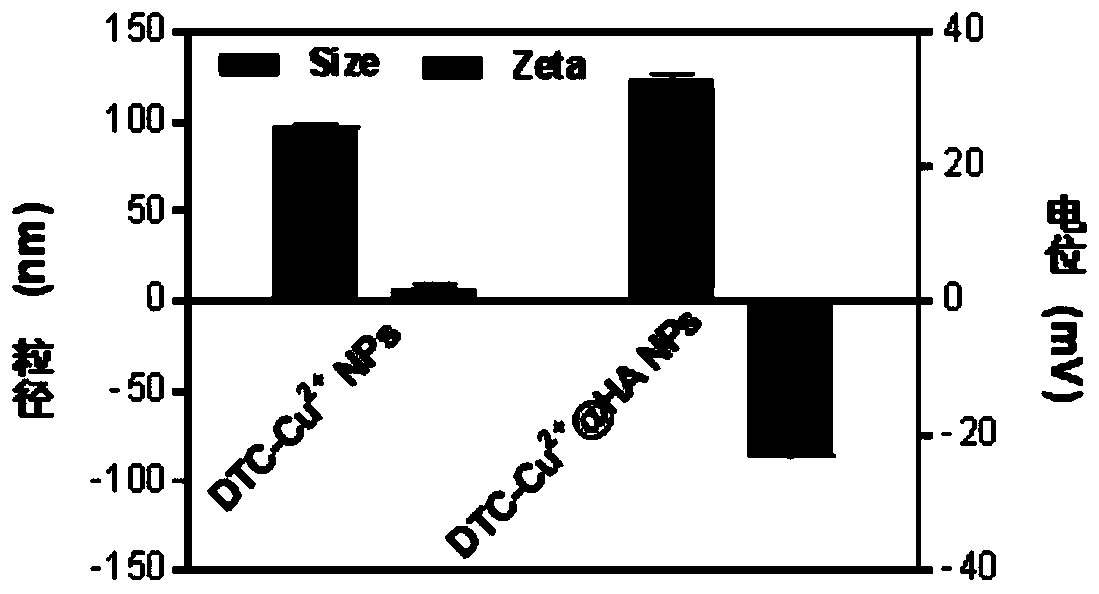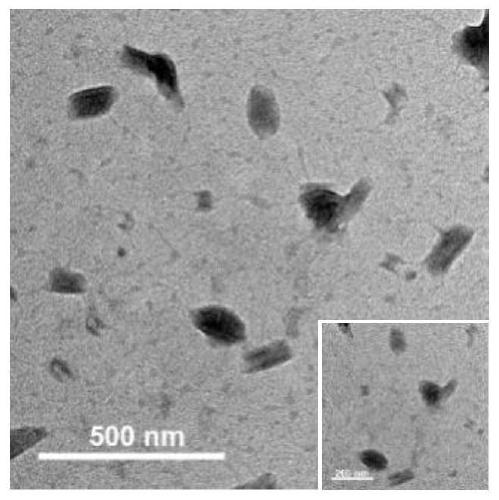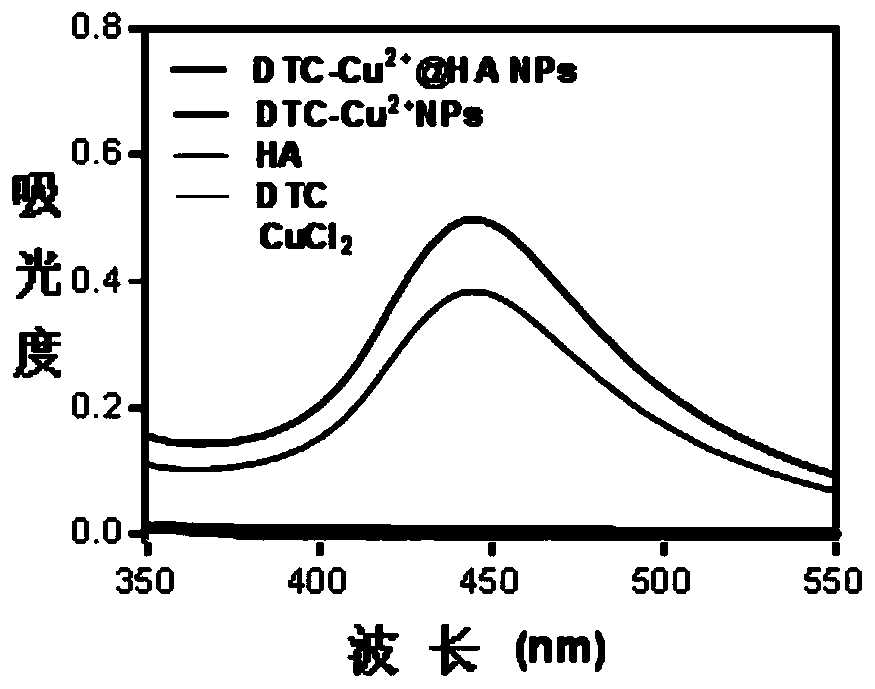Nanometer coordination polymer and preparation method and application thereof
A technology of coordination polymers and polymers, which is applied in pharmaceutical formulations, medical preparations without active ingredients, and medical preparations containing active ingredients, etc., can solve the problems of high cost, toxic and side effects, and reduce toxic and side effects. , The effect of low package load and high process drug load
- Summary
- Abstract
- Description
- Claims
- Application Information
AI Technical Summary
Problems solved by technology
Method used
Image
Examples
Embodiment 1
[0058] A nano-coordination polymer, including sodium disulfide and copper to form a polymer through coordination.
[0059] The nano-coordination polymer of this embodiment is prepared by the following method:
[0060] (1) Take 6 mL of 2 mM dithiocarbamate (DTC) into a 20 mL beaker, add 184 μL of 20 wt % polyvinylpyrrolidone (PVP), and stir at room temperature for 2 min to obtain a mixed solution.
[0061] (2) Use a 5mL syringe to draw 3mL of 2mM CuCl 2 Use a constant flow pump to drip into the mixed solution of the above step (1) with a drop rate of 20 μL / min to obtain sodium dithiocarbamate / copper nano coordination polymer (DTC-Cu 2+ NPs). The reaction solution was dilute to 10 mL for later use.
Embodiment 2
[0063] A nano-coordination polymer, including sodium dithiocarbamate, copper and hyaluronic acid, sodium dithiocarbamate and copper form a polymer through coordination, and hyaluronic acid wraps the above polymer through electrostatic interaction to form a core-shell structure.
[0064] The nano-coordination polymer of this embodiment is prepared by the following method:
[0065] (1) Take 6 mL of 2 mM dithiocarbamate (DTC) into a 20 mL beaker, add 184 μL of 20 wt % polyvinylpyrrolidone (PVP), and stir at room temperature for 2 min to obtain a mixed solution.
[0066] (2) Use a 5mL syringe to draw 3mL of 2mM CuCl 2 Use a constant flow pump to drip into the mixed solution of the above step (1) with a drop rate of 20 μL / min to obtain sodium dithiocarbamate / copper nano coordination polymer (DTC-Cu 2+ NPs). The reaction solution was dilute to 10 mL for later use.
[0067] (3) Accurately weigh 12 mg of hyaluronic acid (HA), dissolve it in 20 mL of distilled water, and prepare a ...
experiment example
[0070] 1. Particle size: detect DTC-Cu separately 2+ NPs and DTC-Cu 2+ The particle size of @HA NPs is measured as follows: take the sample solution and place it in a Marlven Nano ZS instrument, use the dynamic light laser scattering method to detect the particle size, set the temperature of the measurement cell to 25°C, and operate 3 copies of each sample in parallel. figure 1 for DTC-Cu2 + NPs, DTC-Cu 2+ The particle size and potential change diagram of @HA NPs, from the results of the diagram, it can be known that the nano-coordination polymer DTC-Cu 2+ The particle size of NPs is 98nm, the potential is +1.73mV, and the coordination polymer DTC-Cu coated with hyaluronic acid 2+ The particle size of @HA NPs increased to 125nm, and the potential decreased to -23.2mV.
[0071] 2. Morphology: observe DTC-Cu 2+ The morphology of @HA NP, the detection method of the morphology: the sample is dropped on a 400-mesh copper grid covered with a carbon film, placed in a desiccator,...
PUM
 Login to View More
Login to View More Abstract
Description
Claims
Application Information
 Login to View More
Login to View More - R&D
- Intellectual Property
- Life Sciences
- Materials
- Tech Scout
- Unparalleled Data Quality
- Higher Quality Content
- 60% Fewer Hallucinations
Browse by: Latest US Patents, China's latest patents, Technical Efficacy Thesaurus, Application Domain, Technology Topic, Popular Technical Reports.
© 2025 PatSnap. All rights reserved.Legal|Privacy policy|Modern Slavery Act Transparency Statement|Sitemap|About US| Contact US: help@patsnap.com



